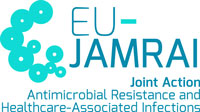Step by step guide for the implementation and assessment of Mobile-learning Apps
Mobile-learning Apps in the context of AMR/AMS are specialized software applications designed for smartphones and tablets. They serve a dual purpose: providing accessible, just-in-time educational content (e.g., microlearning modules, case-based questions) and acting as point-of-care clinical or professional decision-support tools (e.g., providing access to local antimicrobial guidelines, diagnostic algorithms, dosing calculators). Their key advantages include portability, convenience, ability to deliver updated information quickly, and potential for interactive learning and personalized feedback.

Planning a Mobile-learning Apps
The following steps should be taken into consideration when planning a mobile-learning experience on AMR/AMS:
- Needs Assessment and Objective Definition: Identify specific AMR/AMS challenges or needs that a mobile app can effectively address for the target audience (e.g., improving adherence to local prescribing guidelines, providing quick diagnostic support, delivering spaced education on stewardship principles, facilitating access to farm-specific biosecurity protocols). Clearly define the app’s primary function – education, decision-support, or both.
- User-Centered Design and Content Strategy: Design an intuitive, user-friendly interface optimized for mobile devices, ensuring easy navigation and quick access to critical information. Develop concise, accurate, and relevant AMR/AMS content, which may include:
- Localized antimicrobial guidelines and formularies (Tuon et al., 2017).
- Diagnostic and treatment algorithms for common infections.
- Dosing calculators, IV-to-oral switch criteria.
- Interactive microlearning modules or case-based questions with explanations (Bobbitt et al., 2023).
- Information on local resistance patterns and epidemiology.
- Feature Development: Incorporate features relevant to AMR/AMS needs, such as robust search functionality, offline access to essential content, push notifications for urgent updates (e.g., critical guideline changes, new resistance alerts), progress tracking for educational modules, and user feedback mechanisms.
- Technical Development and Rigorous Testing: Develop the app using appropriate technologies. Conduct thorough testing across different mobile operating systems, devices, and screen sizes to ensure stability, performance, and usability.
- Deployment and Dissemination: Deploy the app through official app stores (e.g., Apple App Store, Google Play Store) or via institutional distribution channels. Develop a clear strategy for promoting the app to the target audience.
- User Training and Support: Provide clear instructions on how to download, install, and effectively use the app’s features. Offer ongoing technical support and channels for user queries.
- Content Maintenance and Iterative Improvement: Establish a robust process for regularly reviewing and updating all clinical and educational content to ensure it remains current with AMR/AMS best practices, guidelines, and local data. Collect and analyze user feedback for iterative improvements to app functionality and content.

Defining roles in a Mobile-learning Apps
Facilitator’s role (App Content Manager/AMS Team/Educational Lead): Oversee the accuracy, relevance, and timely updating of all AMR/AMS content within the app. Champion the app’s adoption and effective use among the target audience. Actively gather and analyze user feedback and app analytics to guide iterative improvements and ensure the app continues to meet user needs and support stewardship goals.
Participant’s role (App user): Download, install, and regularly utilize the app as a tool for point-of-care decision-making in AMR/AMS and/or for convenient access to educational content. Engage actively with interactive learning modules or case questions if included. Provide constructive feedback to app developers/managers to contribute to its ongoing improvement and relevance.

Assessing a Mobile-learning Apps
Methods
- Tracking app analytics: number of downloads, active users, frequency of use, features most utilized, session duration.
- User feedback surveys assessing usability (e.g., using System Usability Scale – SUS), satisfaction, perceived usefulness, and impact on confidence in AMR/AMS decision-making or practice. (Bobbitt et al., 2023, reported high user satisfaction and ease of use; Brooke et al., 2022, assessed confidence).
- Pre- and post-intervention (e.g., after a period of app use or completion of in-app educational modules) assessments of knowledge, attitudes, and self-reported practices (KAP) related to AMR/AMS. (Bobbitt et al., 2023, demonstrated significant improvements in KAP scores using an app for microlearning).
- Objective measures of impact on AMR/AMS outcomes, where feasible and attributable: changes in antimicrobial consumption patterns (Tuon et al., 2017, showed reduction in specific antibiotic use), improved adherence to prescribing guidelines, appropriateness of antimicrobial selection, or reduction in specific healthcare-associated infections.
- Analysis of performance on in-app quizzes or case-based questions, if applicable.
Tools
App analytics dashboards (e.g., Google Analytics for Mobile Apps, Firebase), in-app feedback forms or links to external survey tools, validated KAP questionnaires, prescribing audit tools, antimicrobial consumption databases (e.g., DDDs), user satisfaction and usability scales (e.g., SUS).

Suggested Mobile-learning Apps prototype
Target Audience: Food Producers, Wastewater Managers, Prescribers (human and veterinary), Dispensers, Clinical Profiles, Researchers, Educators.
Learning Objectives:
- Provide rapid, point-of-need access to relevant national and local AMR/AMS guidelines, biosecurity protocols, and prudent use recommendations tailored to different professional sectors (human health, animal health, environment).
- Offer decision-support tools for common infectious disease syndromes or environmental AMR mitigation strategies.
- Deliver concise, regularly updated microlearning modules or “AMR alerts” on emerging resistance threats, new research findings, or stewardship best practices across the One Health spectrum.
- Facilitate reporting of suspected AMR issues or successful stewardship interventions (optional feature).
Curriculum/Activities:
- Sector-Specific Guideline Hub: Searchable repository of current national/local AMR guidelines for human medicine, veterinary medicine (by species), and environmental management of AMR.
- Decision-Support Algorithms: Interactive tools for common syndromes (e.g., mastitis in cattle, UTIs in humans, wastewater treatment options for antimicrobial removal) based on local data if available. Includes dosing calculators for relevant profiles.
- “AMR Micro-Learner”: A section with short, engaging modules (videos, infographics, case-based questions with explanations like those in Bobbitt et al. (2023,) on core AMR/AMS topics (e.g., “IPC for AMR Prevention,” “Prudent Use Principles for Farmers,” “Interpreting Antibiograms in [Species/Setting],” “Environmental Hotspots for AMR”). Uses spaced education principles.
- Push Notifications: For urgent AMR alerts (e.g., new multi-drug resistant outbreak locally) or critical updates to guidelines relevant to the user’s selected professional profile.
- Resource Library: Links to key One Health AMR organizations, research papers, and awareness materials.
Evaluation of the Prototype’s Effectiveness:
- Tracking app download rates across different professional profiles, active usage statistics, and utilization of specific features (e.g., which guidelines are accessed most, completion rates for microlearning modules).
- User satisfaction and usability surveys (e.g., using SUS) administered in-app after a set period of use.
- Pre- and post-implementation surveys assessing changes in self-reported confidence in accessing AMR information and making stewardship-informed decisions. (Brooke et al., 2022, found increased confidence).
- If linked to specific institutional or regional AMS programs, monitor relevant metrics like guideline adherence rates or AMU trends. (Tuon et al., 2017, measured impact on AMU).
- Qualitative feedback through in-app forms or targeted user interviews to understand how the app is being used in practice and identify areas for improvement.
References
- Armas Freire, P. I., Gaspar, G. G., Zurita, J., Salazar, G., Velez, J. W., & Bollela, V. R. (2022E-Learning versus Face-to-Face Methodology for Learning Antimicrobial Resistance and Prescription Practice in a Tertiary Hospital of a Middle-Income Country. Antibiotics, 11(12), 1829. https://doi.org/10.3390/antibiotics11121829
- Asif, Q., & Bell, K. (2024). Digital case discussion provides effective education on anti-microbial resistance in low- and middle-income countries. Future Healthcare Journal, 11, 100032. https://doi.org/10.1016/j.fhj.2024.100032
- Bobbitt, L. J., Cimino, C., Garvey, K. V., Craft, L. S., Eichenseer, N. A., & Nelson, G. E. (2023). An app a day: Results of pre- and post-surveys of knowledge, attitudes , and practices (KAP) regarding antimicrobial stewardship principles a mong nurses who utilized a novel learning platform. Antimicrobial Stewardship & Healthcare Epidemiology, 3(1), e41. https://doi.org/10.1017/ash.2023.131
- Brooke, T. R., Pfaeffle, H. O., Guillory, W. O., Raiciulescu, S., & Ressner, R. A. (2022). Making the APPropriate choice: Utilization of a smartphone application to optimize antimicrobial decisions among internal medicine trainees. Antimicrobial Stewardship & Healthcare Epidemiology, 2(1), e194. https://doi.org/10.1017/ash.2022.345
- Rocha-Pereira, N., Lafferty, N., & Nathwani, D. (2015). Educating healthcare professionals in antimicrobial stewardship: Can online-learning solutions help? Journal of Antimicrobial Chemotherapy, 70(12), 3175–3177. https://doi.org/10.1093/jac/dkv336
- Tuon, F. F., Gasparetto, J., Wollmann, L. C., & Moraes, T. P. de. (2017). Mobile health application to assist doctors in antibiotic prescription – an approach for antibiotic stewardship. The Brazilian Journal of Infectious Diseases, 21(6), 660–664. https://doi.org/10.1016/j.bjid.2017.08.002
